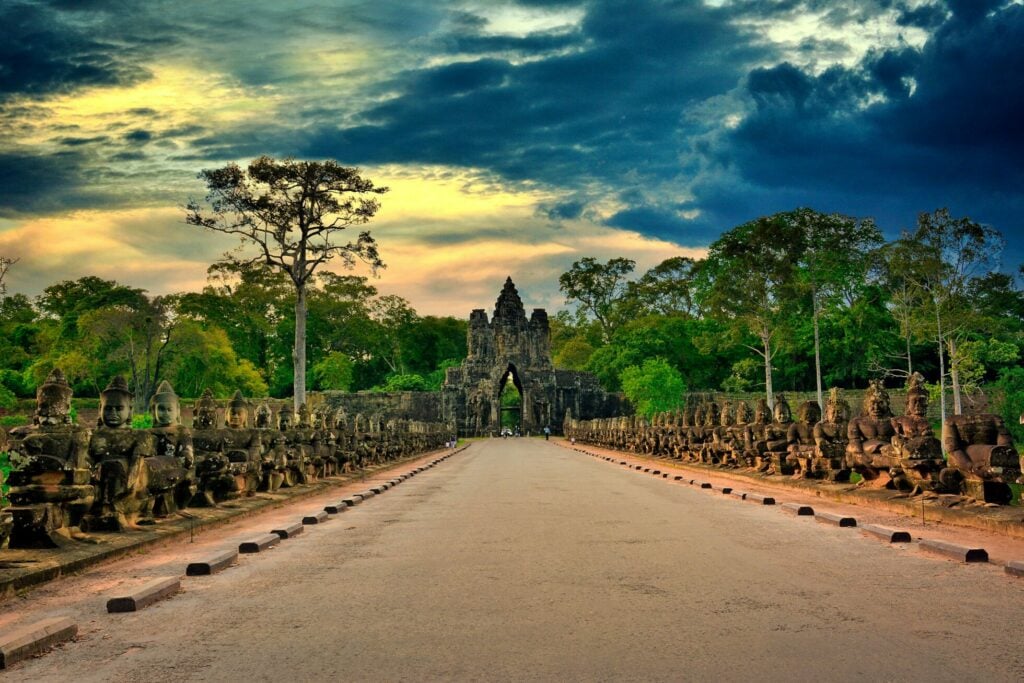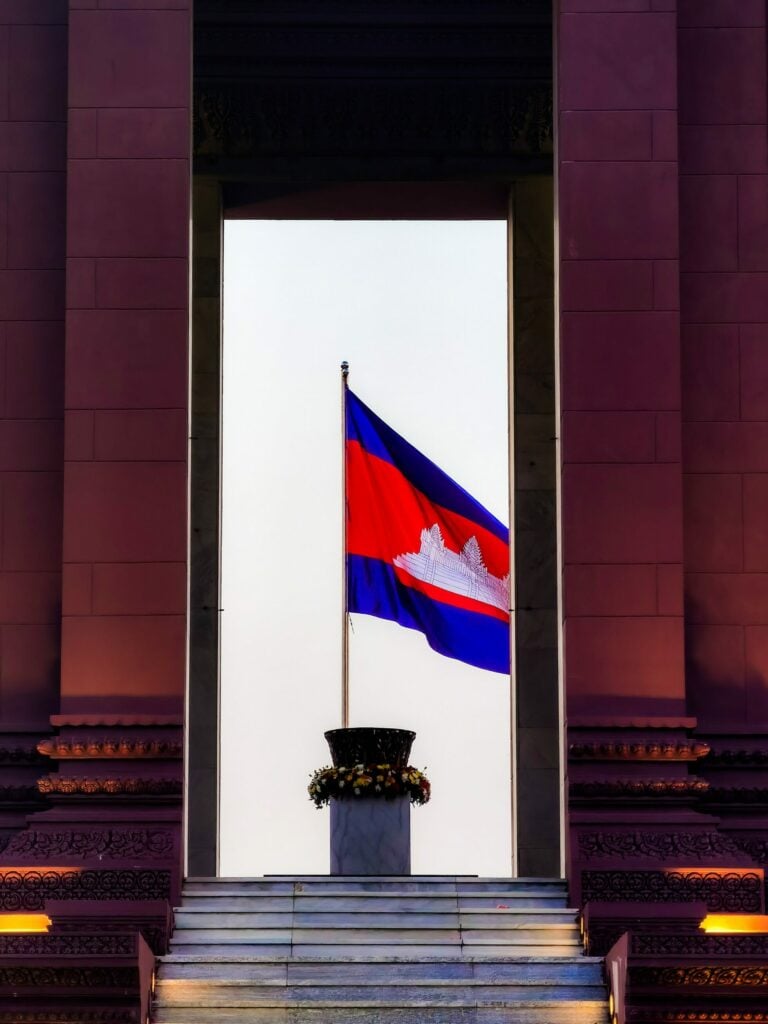Embark on a journey through Barcelona's captivating art and architecture. Explore the visionary works of Gaudí, Picasso, and more, set against the city's stunning landscapes.
GVI
Posted: July 5, 2024

GVI
Posted: February 14, 2023
The flag of Cambodia is composed of two distinctive components: a royal blue field and the highly distinctive intersecting Angkor Wat towers in red. The national flag of Cambodia is steeped in symbolism and is an ubiquitous sight throughout the country. It symbolises the unity of the people, the country’s history, and its nationhood. In this article, we’ll explore the myriad symbolic meanings of the Cambodian flag, its origin, and the controversies that have surrounded it.
The dominant visual element of the Cambodian flag is a depiction of the temple complex known as Angkor Wat, which was once the capital of the great Khmer Empire. The eye-catching silhouette is rendered in bright red against a royal blue backdrop. This iconic shape is thought to represent the Temple as a whole, while its red colour is believed to represent courage, determination and love for the nation. The blue field is widely seen as representing the ever-present vastness of the Cambodian sky.
The temple complex of Angkor Wat is a symbol of national pride for the Cambodian people, and its presence on the flag is a reminder of the country’s rich cultural heritage. The flag also features a white silhouette of three towers, which are believed to represent the three main towers of the temple complex. This imagery is a reminder of the country’s long history and its commitment to preserving its cultural identity.
The current version of the Cambodian flag dates back to the country’s independence in 1953. The royalist government that took control of the country in 1946 initially adopted a plain blue flag with a garland in yellow which was seen as a tribute to the late King Sihanouk. After Cambodia achieved full independence from France in 1953, the flag was modified to include the red depiction of Angkor Wat, creating the iconic design which has served as Cambodia’s national flag to this day.
The red colour of the flag is said to represent the nation’s courage and determination, while the blue colour symbolizes the nation’s purity and justice. The white colour of the temple symbolises the nation’s religion and faith. The flag is also said to represent the country’s commitment to peace and prosperity. The flag is a symbol of national pride and is flown proudly throughout the country.


The two distinct components of the Cambodian flag are united by a unique combination of colour and shape. The royal blue serves as a backdrop for a crimson depiction of Angkor Wat. It’s believed that this combination reflects the merging of strength, resilience and peacefulness that Cambodian culture embraces. The flag is almost square in shape, with a ratio of 2:3. Together, these elements constitute one of the most recognised and beloved symbols of Cambodian identity.
The colours of the Cambodian flag are also symbolic. The royal blue is said to represent the country’s monarchy, while the red is said to represent the nation’s courage and determination. The white temple in the center of the flag is a representation of the Angkor Wat temple, which is a symbol of the country’s rich history and culture. The flag is a reminder of the strength and resilience of the Cambodian people, and is a source of pride for the nation.
The Cambodian flag is one of pride and unity. It has become increasingly important in culture and politics following the difficult years of conflict during Cambodia’s civil war in the 1970s and ‘80s. It is seen not only as a symbol of hope, but also as a reminder to never forget. The Cambodian flag serves as a reminder or an inspiration of what the Cambodian people have endured, how far they have come and how much they have to look forward to.
The flag is a source of national pride and is often seen at public events, such as Independence Day celebrations. It is also used to represent the country in international events, such as the Olympic Games. The flag is a symbol of the country’s resilience and strength, and is a reminder of the importance of unity and solidarity in the face of adversity.
Despite its powerful symbolism, the Cambodian flag has been involved in occasional regional controversies. In 2007, for example, a decision was made by India to abandon its traditional Hindu-influenced flag which featured similar red and blue elements to those on Cambodia’s national flag – after fears arose that parts of India may confuse it with Cambodia’s.
The controversy surrounding the Cambodian flag has also extended to other countries in the region. In 2009, Thailand’s Ministry of Foreign Affairs issued a statement expressing concern over the similarity between the Cambodian and Thai flags. The statement noted that the two flags were too similar and could lead to confusion, and that Thailand was considering changing its flag to avoid any potential misunderstandings.
The Cambodian flag has become increasingly popular in recent years, with many recognising its now universal symbolism. This can be seen through its increasing presence on football kits, wedding invitations, t-shirts and other merchandise that bear this iconic design. It has come to symbolise a sense of identity in many Cambodians and an increasingly strong sense of national pride.
It’s important to respect the laws and guidelines associated with flying any nation’s flag. In addition to being displayed in horizontally or vertically, there are several historical rules surrounding how you should display Cambodia’s national flag. Visiting dignitaries at official events are expected to stand with their hands placed just below their waist with both palms facing up during national anthems or at other times when salutes are exhibited.
The national flag of Cambodia possesses powerful cultural and historical meaning for the country and its people. Its bold combination of red and blue helps it stand out distinguishably amongst other flags in the world. From local protests to global spectator sports, the flag is a strong reminder of strength and resilience that embodies much of Cambodian culture today.
If you’re interested in learning more about Cambodia and its history and culture, joining a GVI program in Siem Reap is a great way to immerse yourself in the local community. By participating in a volunteer or internship program, you’ll have the chance to work alongside local partner organisations, meet new people, and develop skills that will benefit you for a lifetime. With programs in areas such as education, community development, and environmental conservation, GVI provides opportunities for volunteers to gain hands-on experience and make a lasting difference.

Embark on a journey through Barcelona's captivating art and architecture. Explore the visionary works of Gaudí, Picasso, and more, set against the city's stunning landscapes.
GVI
Posted: July 5, 2024